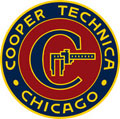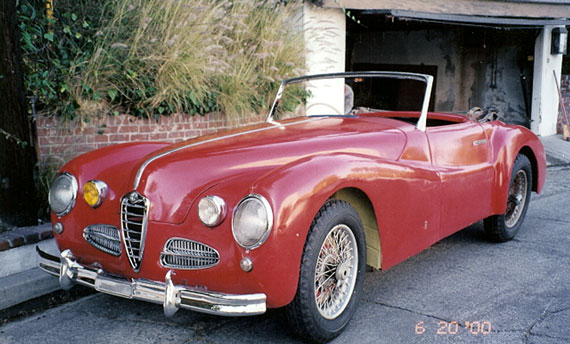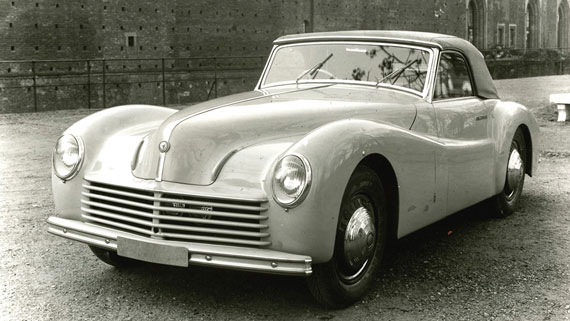Begin at the Beginning:
Historical Research and Forensic Sleuthing Inform the Restoration of the von Richthofen 1943 Alfa Romeo 6C2500
©2015 David Cooper, President, Cooper Technica, Inc.
This article was adapted from a presentation by David Cooper at the October 2014 Historic Vehicle Association (HVA) National Automotive Heritage Summit, convened in Washington D.C. in conjunction with the Smithsonian Museum. The subject was how Cooper Technica’s painstaking research and innovative restoration techniques allow it not only to preserve original components, but also to achieve unprecedented accuracy in restoration. The example presented was a 1943 Alfa Romeo 6C2500 Super Sport Cabriolet now under restoration.
Introduction
 My company, Cooper Technica, Inc., has been privileged to work on some of the greatest automobiles ever made. At our workshops in Chicago, Illinois and in Lyon, France, we restore rare and valuable vintage European cars from the 1930s and 1940s. These specially selected cars embody the best of pre-WWII creativity and engineering genius.
My company, Cooper Technica, Inc., has been privileged to work on some of the greatest automobiles ever made. At our workshops in Chicago, Illinois and in Lyon, France, we restore rare and valuable vintage European cars from the 1930s and 1940s. These specially selected cars embody the best of pre-WWII creativity and engineering genius.
Because these cars are an important historical record, collectors and restorers share the responsibility to preserve these cars as much as possible in their original condition. Often the best option is to do a mechanical restoration only, and leave the body in its ‘as found’ state. However, some cars are too far gone to leave it ‘as found’. Either the deterioration is too extensive, or previous attempts at restoration destroyed or lost original components. For these cars, the question is, how to restore them to preserve as much of the original car as possible, and also to insure that the restored car is accurate and authentic to the original.
To achieve the highest degree of authenticity and originality, we must be more than restorers; we must be meticulous automotive historians and dauntless forensic sleuths.
Why? Because we cannot bring a car back to original without knowing what original was. We must learn how the car came to be in its current condition and configuration. Most of what we need to know cannot be found even in our extensive research library, much less in magazines or auction descriptions.
This article tells the story of an exceptional 1943 Alfa Romeo. Part I describes our journey tracking the history and documenting the car. Part II, to be published in the next issue, will describe how, based on this research, we preserve original components while achieving unprecedented accuracy in restoration, through combining the latest laser scanning and digital imaging technology with the construction techniques and methods of the 1930s.
To acquire, research and document the history of this Alfa Romeo, I crossed two oceans; sifted through private archives throughout Western Europe; and located and interviewed persons with first-hand knowledge of the car and other events from the 1940s. Admittedly, this is an extreme approach, but to do justice to the most valuable cars, it is more than justifiable: it is essential.
Investigation begins at the acquisition

1943 Alfa Romeo 6C 2500 Super Sport Cabriolet in California in 2000 with the later type 1900 grille and extra headlights added in 1953. Author collection.
In early 2007, a friend alerted me to a rare Alfa Romeo 6C2500 Super Sport that was for sale in Christchurch, New Zealand. Someone had made the bare beginnings of a restoration, and the car was for sale “as is”. Before the current owner brought it to Asia, the car had been owned by a Los Angeles collector for many years, during which it was painted red and disguised with a grille from a later Alfa 1900 model.
When I arrived in Christchurch to inspect the car, I found it entombed amid boxes of its own disassembled parts, with more of the same stacked on nearby shelves. As difficult as it is to evaluate a car in that condition, that’s my specialty. Once the boxes were off the car, I observed that the paint had been stripped from the aluminum body, and that weld lines betrayed modifications and repairs made over the years — including one bad repair with fiberglass. Panels were badly dented, and one front fender was cracked where it met the cowl — an evident stress point in the body design.
Even then, the car presented mysteries. Though the 1900 model narrow grille was mounted in a steel panel, the rest of the body was aluminum. Underneath the steel panel, I could see the mounting holes for the original horizontal grille slats. Evidently, the aluminum hood had been modified to accept the taller and narrower 1900 model grille — but when, and why, did that happen? In any case, having made a thorough inventory of all the parts and taken extensive photos, I concluded that the asking price was reasonable — despite the car’s condition. I bought it and had it shipped to Chicago.
Identification of the Alfa Romeo

Photo of a similar but verifiably different car from Alfa Romeo’s archives. Note the odd latch handles on both sides of the hood.
Since we had the chassis number 915.522, the first step was to check Alfa Romeo’s own records, which showed the chassis was completed on December 9, 1942; the body completed on October 26, 1943; and the original owner as Luftwaffe Field Marshal Wolfram von Richthofen. The car was one of the 28 Alfa Romeo cars made during WWII—only for Mussolini’s close friends and associates, mostly high-ranking German officers. All were 6C2500 Super Sports with a short wheelbase chassis for better handling and a more powerful three-carburetor 2.5 liter engine. Seven had custom cabriolet bodies by one of the great Italian coachbuilders, Pinin Farina. Our car was one of them.